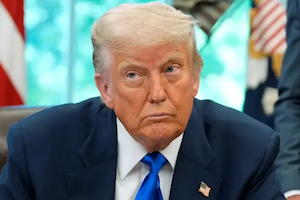Trump Announces 50% Tariff on EU Starting June 1, Triggering Global Market Turmoil

U.S. President Donald Trump has once again made headlines by announcing via social media that starting June 1, he plans to impose a 50% tariff on goods from the European Union—just hours before scheduled trade talks between the U.S. and EU. The announcement sent shockwaves through global financial markets, with major U.S. and European stock indices closing in the red, triggering renewed volatility across global stock and currency markets.
On May 23, Trump first posted that he would impose at least a 25% tariff on iPhones produced overseas, stating, "I’ve long told Apple’s Tim Cook that iPhones destined for the U.S. should be made in America—not in India or elsewhere." He followed up with another post criticizing the EU, claiming it has been "very difficult to deal with" on trade and that "no progress" has been made, threatening to slap a 50% tariff on EU goods starting June 1.
The EU has long resisted Trump’s demands, particularly regarding the value-added tax (VAT), which Trump views as an unfair trade practice. Valdis Dombrovskis, the European Commissioner for Economic Policy, previously stated that VAT is not part of bilateral trade negotiations. He emphasized that the U.S.-EU trade relationship is unique and must be based on mutual respect rather than threats, adding that the EU is ready to defend its interests at any time.
Following Trump’s posts, stock markets in both the U.S. and Europe initially plummeted, but losses narrowed by the end of the trading day. The S&P 500 ultimately closed down 0.67%. Many analysts believe Trump's threat is yet another negotiation tactic. According to the Financial Times, the industries most likely to be impacted by the proposed tariffs include pharmaceuticals, aerospace, and automotive sectors. EU Commission data shows that the U.S. is the EU’s largest trading partner, with exports to the U.S. exceeding €530 billion in 2024. Major exporters include Germany, France, Italy, and Ireland.
In April, Trump introduced the idea of "reciprocal tariffs" on all U.S. trade partners, initially setting the EU rate at 20%, then postponing implementation for 90 days to allow for negotiations. The New York Times reports that the EU had offered to significantly reduce tariffs on a reciprocal basis and to increase purchases of U.S. energy products. However, European officials have often expressed frustration over the unclear objectives of U.S. trade policy and uncertainty over who is actually in charge. Trump’s unpredictable stance has added to the confusion. Observers believe Trump ultimately aims to bring manufacturing back to the U.S. and boost domestic employment. However, multiple media outlets have pointed out that manufacturing products like the iPhone domestically poses serious challenges, including a lack of supporting supply chains and a shortage of large numbers of low-cost skilled workers. Implementing such a shift abruptly would result in high costs and logistical hurdles.
- 59 reads
Human Rights
Fostering a More Humane World: The 28th Eurasian Economic Summi

Conscience, Hope, and Action: Keys to Global Peace and Sustainability

Ringing FOWPAL’s Peace Bell for the World:Nobel Peace Prize Laureates’ Visions and Actions

Protecting the World’s Cultural Diversity for a Sustainable Future

Puppet Show I International Friendship Day 2020

